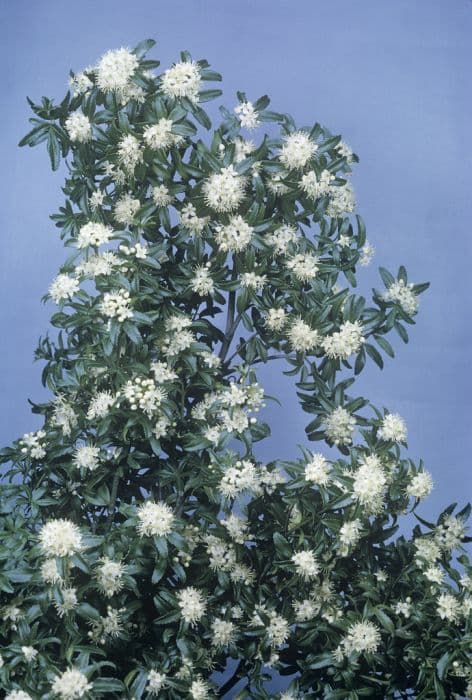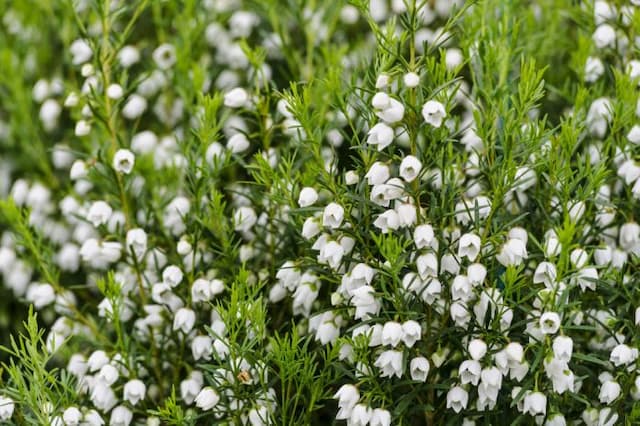Skimmia Skimmia japonica subsp. reevesiana 'Chilan Choice' (f/m)

ABOUT
The plant you're asking about, known commonly as Skimmia, has a lush and attractive appearance, notable for its evergreen foliage and striking flowering and fruiting characteristics. The leaves are a deep, glossy green that emanate from the branches, providing a dense and robust look throughout the year. During the flowering season, this variety of Skimmia produces clusters of small, fragrant flowers. These blossoms can vary in color, but they often have a creamy-white tone that stands in lovely contrast to the dark foliage. After the flowering period, if both female and male plants are present, bright red berries can develop, which persist into winter and add a splash of color to the wintery landscape. These berries are particularly eye-catching and are a favorite among gardeners for their ornamental value, as well as being a source of food for birds during the colder months. The overall aesthetic of the Skimmia is one of vibrant greenery accompanied by seasonal bursts of flowers and fruits, lending a charming and decorative element to any garden space where size constraints are not an issue.
About this plant
 Names
NamesFamily
Rutaceae
Synonyms
Reeves Skimmia, Japanese Skimmia
Common names
Skimmia reevesiana, Skimmia japonica var. reevesiana.
 Toxicity
ToxicityTo humans
Skimmia, including the variety Skimmia japonica 'Chilan Choice,' is considered to have a degree of toxicity to humans. If any part of the plant is ingested, it can cause symptoms such as vomiting, diarrhea, and abdominal pain. In some cases, more severe symptoms could occur, particularly if large amounts are consumed. It is advisable to seek medical attention if ingestion is suspected.
To pets
Skimmia is toxic to pets. If a pet ingests part of a Skimmia japonica 'Chilan Choice' plant, symptoms of poisoning could include vomiting, diarrhea, weakness, and abdominal pain. The severity of the symptoms can vary depending on the amount ingested and the size of the pet. It is important to contact a veterinarian immediately if you suspect your pet has consumed any part of this plant.
 Characteristics
CharacteristicsLife cycle
Perennials
Foliage type
Evergreen
Color of leaves
Dark green
Flower color
White
Height
3 feet 3 inches (1 m)
Spread
3 feet 3 inches (1 m)
Plant type
Shrub
Hardiness zones
7
Native area
China
Benefits
 General Benefits
General Benefits- Evergreen Foliage: Skimmia japonica maintains its lush, green leaves throughout the year, providing constant visual interest in gardens.
- Compact Growth: Its compact growth habit makes it suitable for small gardens, borders, and container planting.
- Shade Tolerance: The plant is well-adapted to shade, making it ideal for planting under trees or in other low-light areas of the garden.
- Low Maintenance: It requires minimal pruning and care, making it a low-maintenance option for gardeners.
- Deer Resistance: The foliage is not favored by deer, reducing the risk of damage in areas with a deer population.
- Winter Interest: Skimmia japonica produces red berries in the winter, adding color to the otherwise dull winter landscape.
- Pollinator Attraction: The flowers attract bees and other pollinators to the garden, supporting local ecosystems.
- Scented Flowers: The plant boasts fragrant white to ivory flowers that can add a pleasant scent to the garden in spring.
- Drought Tolerance: Once established, it can tolerate periods of drought, making it suitable for xeriscaping or low-water gardens.
- Year-Round Interest: With its combination of evergreen foliage, fragrant flowers, and attractive berries, it offers visual interest across all seasons.
 Medical Properties
Medical PropertiesThis plant is not used for medical purposes.
 Air-purifying Qualities
Air-purifying QualitiesThis plant is not specifically known for air purifying qualities.
 Other Uses
Other Uses- Decorative Potpourri: Dried Skimmia japonica leaves and berries can be added to potpourri mixes to provide a unique forest-like scent and visual appeal.
- Photography Prop: The plant can serve as an attractive background or focal point in photography, especially during its blooming season for a natural aesthetic.
- Culinary Garnish: Although not edible, the leaves and flowers could be used temporarily to garnish dishes for presentation purposes, then removed before consumption.
- Craft Material: Its sturdy stems and attractive foliage can be used in making wreaths or other decorative crafts.
- Miniature Gardens: Due to its small size and dense foliage, it can be included in fairy or miniature gardens as a decorative element.
- Ink Making: Berries of the plant could potentially be used to make natural dyes or inks for art projects as an eco-friendly option.
- Natural Fencing: When planted in rows or groups, Skimmia japonica can act as informal green fencing or screening for privacy in gardens.
- Education and Research: The plant could be used for botanical studies or in educational settings to teach about plant biology and reproduction.
- Perfumery: The essential oils from the plant could be explored for inclusion in natural perfume formulations.
- Landing Pad for Insects: Skimmia japonica's flowers can provide a landing spot for beneficial insects such as bees and butterflies, enhancing local biodiversity.
Interesting Facts
 Feng Shui
Feng ShuiSkimmia is not used in Feng Shui practice.
 Zodiac Sign Compitability
Zodiac Sign CompitabilitySkimmia is not used in astrology practice.
 Plant Symbolism
Plant Symbolism- Protection: Skimmia is often associated with protection due to its robust nature and evergreen leaves, suggesting resilience and a shielding presence throughout the seasons.
- Peace: Its calming green foliage and the harmonious structure of the plant can symbolize peace and tranquility in a garden setting.
- Longevity: As an evergreen, Skimmia represents longevity and the idea of enduring through time, much like it endures through seasonal changes.
- Femininity: With its delicate and fragrant flowers, Skimmia can represent feminine qualities such as grace, beauty, and nurturing.
- Balance: The plant's symmetry and the way it balances its growth between foliage and flowers can symbolize the importance of balance and harmony in life.
 Water
WaterSkimmia japonica, also known as Skimmia, prefers consistent moisture without becoming waterlogged. The ideal watering routine is to provide the plant with about 1 inch of water weekly, adjusting for rainfall. During dry spells or in the heat of summer, water Skimmia twice a week, especially if it's planted in well-draining soil. Use a soaker hose or drip irrigation to deliver water directly to the root zone, minimizing evaporation and keeping the foliage dry, thereby reducing the risk of disease. In winter, when the plant is dormant and the soil retains moisture longer, reduce watering frequency.
 Light
LightSkimmia thrives in partial shade, ideally in a location that offers morning light with protection from harsh afternoon sun. The best spot for Skimmia is an area that receives dappled sunlight throughout the day or a place with bright, indirect light. Direct sunlight, especially during the hot summer months, can scorch the leaves and cause stress to the plant.
 Temperature
TemperatureSkimmia is hardy in USDA zones 7 to 9 and tolerates temperatures as low as 10°F during dormancy. However, it thrives in conditions where average temperatures range from 60°F to 75°F. Protect Skimmia from extreme heat by providing adequate shade and mulch to maintain soil moisture and cooler root conditions.
 Pruning
PruningPrune Skimmia to maintain its shape and encourage bushier growth; this is best done in the spring after flowering. Pruning can also help remove any dead or damaged branches to prevent disease and improve air circulation. Annually, thin out older stems to rejuvenate the plant and allow light to reach the interior branches. It typically doesn't require heavy pruning, so be conservative with your cuts.
 Cleaning
CleaningAs needed
 Soil
SoilSkimmia prefers well-draining, humus-rich soil. A mix containing 50% ericaceous compost and 50% peat or peat substitute provides the right structure and nutrients. This plant thrives in slightly acidic soil with a pH between 5.5 and 6.5, ensuring healthy growth and flowering.
 Repotting
RepottingReeves Skimmia should be repotted every two to three years to replenish the soil and address root growth. They do not typically require frequent repotting due to their slow growth rate.
 Humidity & Misting
Humidity & MistingReeves Skimmia enjoys moderate to high humidity levels; a range of 40-60% is ideal for this plant. It's important to keep the environment consistently humid without overwatering, to maintain plant health and vigor.
 Suitable locations
Suitable locationsIndoor
Place in bright, indirect light, with cool temps and high humidity.
Outdoor
Partial shade, sheltered location, well-drained acidic soil.
Hardiness zone
7-9 USDA
 Life cycle
Life cycleSkimmia japonica subsp. reevesiana 'Chilan Choice', commonly known as Reeves Skimmia, begins its life cycle as a seed which germinates to produce a small seedling, often requiring stratification to break dormancy. The seedling then grows into a juvenile plant, developing a compact, rounded habit and leathery, dark green leaves. As it matures, the juvenile plant transitions to the adult phase, characterized by the development of flower buds in autumn, followed by the blooming of fragrant white flowers in late winter to early spring, which, depending on the sex of the plant, may be followed by bright red berries in female plants. After flowering, the plant enters a period of vegetative growth throughout the spring and summer months. Over several years, Reeves Skimmia can become a dense, evergreen shrub up to 1 meter tall, and it maintains its glossy foliage year-round. The plant is relatively low-maintenance, requiring little pruning, and can live for many years, with some specimens surviving for several decades under optimal conditions.
 Propogation
PropogationPropogation time
Spring-Early Summer
Propogation: The Skimmia japonica, commonly known as Japanese Skimmia, is propagated most effectively by semi-hardwood cuttings. Optimal propagation time is in late summer to early fall when the plant's growth begins to harden but is not yet fully mature. To propagate by cuttings, a gardener would cut a 4- to 6-inch length (about 10 to 15 cm) from a healthy branch, ensuring it includes at least two sets of leaves. The bottom set of leaves is removed, and the cut end is dipped into rooting hormone to encourage root development. Then, the cutting is inserted into a pot filled with a well-draining propagation mix, such as a blend of peat and perlite. The cutting should be kept in a humid environment with indirect light until roots have formed, which typically takes several weeks. Once the cuttings have rooted and show signs of new growth, they can be transplanted into individual pots or into the garden.


![Mexican orange [Sundance]](/_next/image?url=https%3A%2F%2Fplants-admin.emdemapps.com%2Fimages%2Fplants%2F%2Fimages%2F604b5381bcf0d.png&w=640&q=75)






